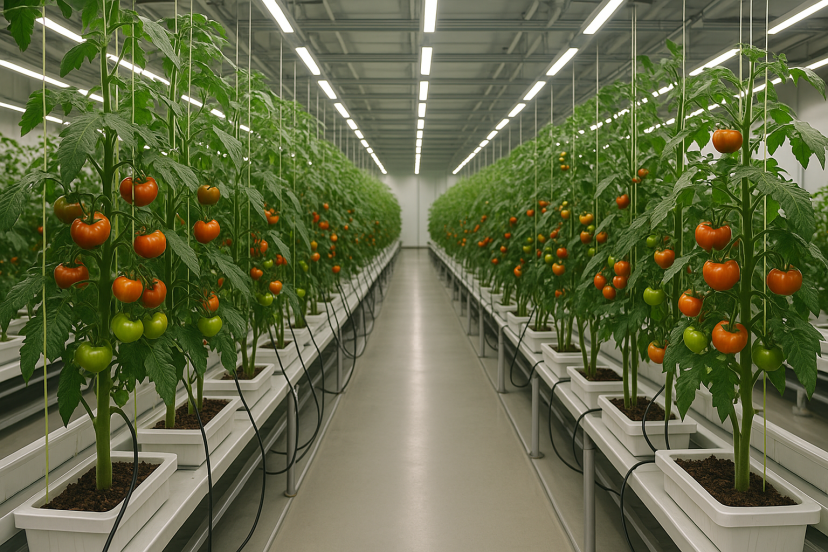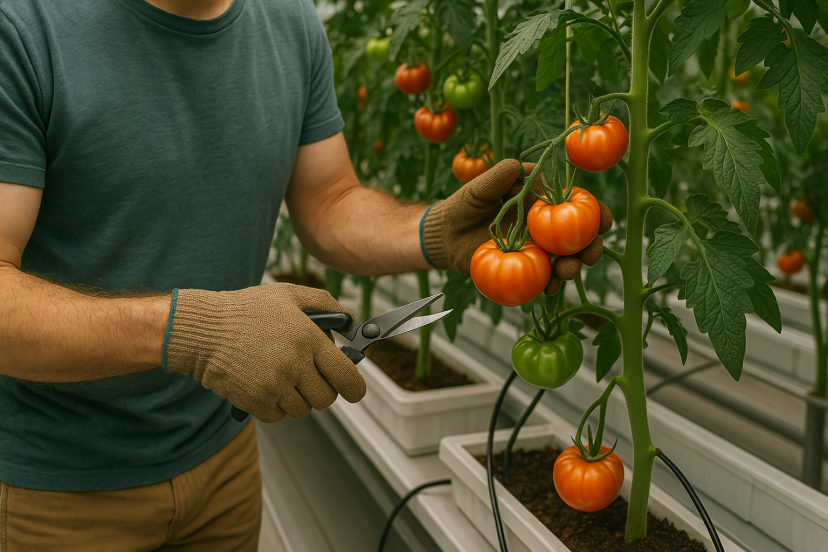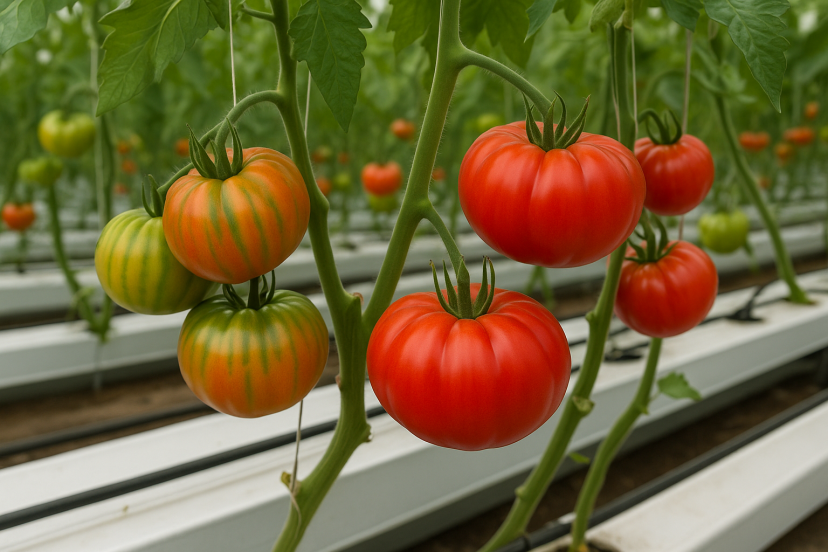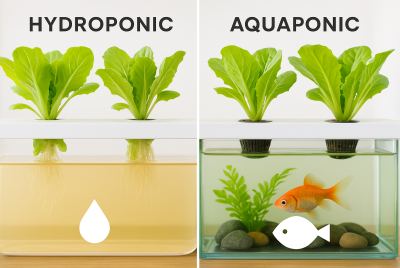How To Grow And Take Care Of Heirloom Tomatoes Without Soil
We may earn a commission for purchases made using our links. Please see our disclosure for more details.
Growing heirloom tomatoes without soil may sound unusual at first, but it’s actually one of the easiest ways to enjoy fresh, flavorful tomatoes at home. Hydroponic setups give you full control over water, light, and nutrients, which helps these delicate varieties grow strong and taste amazing. You don’t need a big garden or perfect soil—just a small space, the right tools, and a little consistency. With the right approach, you can enjoy reliable harvests, fewer pests, and vibrant heirloom tomatoes all year long.
What Makes Heirloom Tomatoes So Special?
Heirloom tomatoes aren’t just colorful or pretty. They’re living history. These varieties have been passed down for generations, usually for one simple reason: incredible taste.
Unlike hybrid tomatoes bred for long shelf life, heirlooms are selected for flavor, texture, and unique characteristics. Some are sweet and fruity. Others are smoky or rich. You’ll even find varieties with marbled skins, deep purples, stripes, or stunning golden flesh.
Because they’re genetically diverse, they adapt beautifully to controlled hydroponic systems. When you remove soil-related stress, heirloom tomatoes often grow stronger, fruit earlier, and produce more consistently.
Why Grow Heirloom Tomatoes Without Soil?
Growing tomatoes hydroponically has become popular for a reason. Here’s why so many home growers have made the switch:
Cleaner and More Controlled
No soil means no guesswork. Nutrients go directly to the roots, so your plants don’t have to “hunt” for anything.
Faster Growth
Tomatoes grown in hydroponic systems can develop significantly quicker, sometimes reaching maturity 30–50% sooner than those in soil. A 2019 study in Horticulturae found that hydroponic systems significantly improved tomato growth and yield compared to traditional soil methods.
Fewer Pests and Diseases
Soil attracts fungus, nematodes, and bacteria that never become a problem in water-based systems.
Perfect for Small Spaces
Apartment kitchen? Balcony? Spare corner by a window? Hydroponics fits almost anywhere.

Best Hydroponic Systems for Heirloom Tomatoes
You don’t need fancy commercial equipment. Many beginners start with simple setups and upgrade later.
Deep Water Culture (DWC)
It’s an option that works well for anyone just starting out. Roots sit in nutrient-rich water, and an air pump keeps everything oxygenated.
Kratky Method
Low-maintenance and doesn’t require electricity. Ideal for starts or smaller tomato varieties.
Drip Systems
Perfect for larger heirloom tomatoes since they require steady nutrient delivery.
Nutrient Film Technique (NFT)
A shallow, steady flow of nutrient solution moves along the roots to keep them fed. It uses less water but requires more attention.
Each system works, so choose one that suits your space and comfort level.
Step-by-Step Guide: Growing Heirloom Tomatoes Hydroponically
Step 1: Choose the Right Variety
Some heirlooms are sprawling giants, while others stay compact. A few beginner-friendly options include:
- Cherokee Purple
- Brandywine Pink
- Green Zebra
- Black Krim
- Kellogg’s Breakfast
Indeterminate varieties produce all season but need support. Determinate ones are shorter and easier to manage.
Step 2: Set Up Your Hydroponic System
Pick any of the systems above and set it up where you have bright light or grow lamps. Make sure the reservoir is large enough so nutrient levels stay steady.
Step 3: Provide Proper Light and Temperature
Tomatoes need 12–14 hours of bright light daily. If you’re indoors, choose full-spectrum LED grow lights.
Keep temperatures between:
- Day: 70–75°F (21–24°C)
- Night: 62–68°F (16–20°C)
Step 4: Mix and Maintain Nutrients
Tomatoes are heavy feeders. Choose hydroponic nutrients with a balanced N-P-K ratio, and adjust as plants mature.
Early growth requires more nitrogen.
Flowering and fruiting benefit from increased potassium.
Check pH levels weekly. Aim for 5.8–6.5 to help roots absorb nutrients efficiently.
Step 5: Support and Train the Plants
Heirloom tomatoes grow aggressively. Add a trellis, stake, or string support to keep vines upright. Prune suckers for better airflow and bigger fruit.
Recommended Products
Here are beginner-friendly tools that simplify setup and daily care:
- AeroGarden Bounty Hydroponic System – Excellent for growing compact heirloom varieties indoors.
- General Hydroponics Flora Series Nutrients – Reliable nutrient trio used by hobbyists and researchers.
- VIVOSUN 4FT Full Spectrum LED Grow Light – Helps tomatoes develop strong stems and abundant fruit.
- Clay Pebbles (LECA Media) – Great for drip or DWC systems, offering strong root support.
- VIVOSUN Air Pump – Keeps water oxygenated to prevent root rot.
Common Issues and How to Fix Them
Even with hydroponics, tomatoes can face a few challenges.
Yellowing Leaves
Often caused by pH imbalance or nitrogen deficiency. Test and adjust your solution immediately.
Blossom Drop
Temperature swings can cause flowers to fall. Keep the environment stable.
Nutrient Burn
Leaf tips turning brown? Dilute your nutrient mix.
Root Rot
If roots look brown or smell sour, increase oxygen circulation and replace nutrient solution.

Why Hydroponic Heirlooms Grow So Well
It’s easy to assume soil-grown tomatoes automatically taste better, especially when you’re talking about delicate heirloom varieties—but newer research paints a different picture.
A 2021 study in Scientia Horticulturae found that tomatoes grown in deep water culture (DWC) hydroponics weren’t just more water-efficient; they also developed equal or higher levels of carotenoids like lycopene and β-carotene compared to soil-grown fruit. This is significant because these compounds influence both flavor and nutritional value, two qualities heirlooms are prized for.
Another comprehensive review published in 2024 in Foods compared conventional, organic, and hydroponic tomatoes and found that while organic systems sometimes produced slightly higher lycopene, hydroponic tomatoes often offered better firmness, texture, and overall sensory appeal. For anyone growing heirloom varieties without soil, these findings reinforce that hydroponics doesn’t compromise quality—in many cases, it creates the ideal conditions for consistent, flavorful harvests.
Extra Tip: Companion Planting in Hydroponics
Even without soil, tomatoes benefit from certain “companion” plants. Basil, lettuces, and leafy herbs grow well alongside tomatoes in many hydroponic systems. To discover more options, explore this guide on the best plants for hydroponics.
Conclusion
Growing heirloom tomatoes without soil opens up a world of flavor, convenience, and creativity. You no longer need perfect garden soil or a big backyard. With the right hydroponic setup, consistent nutrients, and supportive lighting, these beloved tomato varieties can thrive in small spaces while producing delicious, high-quality fruit.
Start small, learn as you go, and enjoy fresh heirloom tomatoes right from your hydroponic system. Once you taste your first harvest, you’ll understand why so many growers fall in love with soilless gardening.
FAQs
1. Are heirloom tomatoes good for hydroponics?
Yes. They adapt well and often grow faster and more consistently compared to soil.
2. How long do heirloom tomatoes take to mature hydroponically?
Most varieties take 70–90 days, depending on the specific type and growing conditions.
3. Do hydroponic tomatoes taste the same as soil-grown ones?
They often taste better because nutrients and moisture are perfectly balanced.
4. What pH range works best for growing tomatoes in a hydroponic setup?
A pH between 5.8 and 6.5 helps roots absorb nutrients efficiently.
5. Can I grow heirloom tomatoes indoors year-round?
Absolutely. With LED grow lights and stable temperatures, you can harvest tomatoes any time of year.




